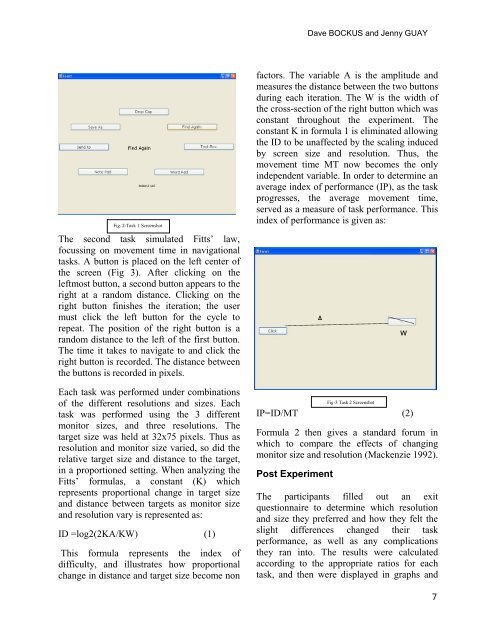Task Performance Metrics on Liquid Crystal Displays - Computer ...
Task Performance Metrics on Liquid Crystal Displays - Computer ...
Task Performance Metrics on Liquid Crystal Displays - Computer ...
Create successful ePaper yourself
Turn your PDF publications into a flip-book with our unique Google optimized e-Paper software.
Dave BOCKUS and Jenny GUAY<br />
Fig. 2-<str<strong>on</strong>g>Task</str<strong>on</strong>g> 1 Screenshot<br />
The sec<strong>on</strong>d task simulated Fitts’ law,<br />
focussing <strong>on</strong> movement time in navigati<strong>on</strong>al<br />
tasks. A butt<strong>on</strong> is placed <strong>on</strong> the left center of<br />
the screen (Fig 3). After clicking <strong>on</strong> the<br />
leftmost butt<strong>on</strong>, a sec<strong>on</strong>d butt<strong>on</strong> appears to the<br />
right at a random distance. Clicking <strong>on</strong> the<br />
right butt<strong>on</strong> finishes the iterati<strong>on</strong>; the user<br />
must click the left butt<strong>on</strong> for the cycle to<br />
repeat. The positi<strong>on</strong> of the right butt<strong>on</strong> is a<br />
random distance to the left of the first butt<strong>on</strong>.<br />
The time it takes to navigate to and click the<br />
right butt<strong>on</strong> is recorded. The distance between<br />
the butt<strong>on</strong>s is recorded in pixels.<br />
Each task was performed under combinati<strong>on</strong>s<br />
of the different resoluti<strong>on</strong>s and sizes. Each<br />
task was performed using the 3 different<br />
m<strong>on</strong>itor sizes, and three resoluti<strong>on</strong>s. The<br />
target size was held at 32x75 pixels. Thus as<br />
resoluti<strong>on</strong> and m<strong>on</strong>itor size varied, so did the<br />
relative target size and distance to the target,<br />
in a proporti<strong>on</strong>ed setting. When analyzing the<br />
Fitts’ formulas, a c<strong>on</strong>stant (K) which<br />
represents proporti<strong>on</strong>al change in target size<br />
and distance between targets as m<strong>on</strong>itor size<br />
and resoluti<strong>on</strong> vary is represented as:<br />
ID =log2(2KA/KW) (1)<br />
This formula represents the index of<br />
difficulty, and illustrates how proporti<strong>on</strong>al<br />
change in distance and target size become n<strong>on</strong><br />
factors. The variable A is the amplitude and<br />
measures the distance between the two butt<strong>on</strong>s<br />
during each iterati<strong>on</strong>. The W is the width of<br />
the cross-secti<strong>on</strong> of the right butt<strong>on</strong> which was<br />
c<strong>on</strong>stant throughout the experiment. The<br />
c<strong>on</strong>stant K in formula 1 is eliminated allowing<br />
the ID to be unaffected by the scaling induced<br />
by screen size and resoluti<strong>on</strong>. Thus, the<br />
movement time MT now becomes the <strong>on</strong>ly<br />
independent variable. In order to determine an<br />
average index of performance (IP), as the task<br />
progresses, the average movement time,<br />
served as a measure of task performance. This<br />
index of performance is given as:<br />
A<br />
Fig-3 <str<strong>on</strong>g>Task</str<strong>on</strong>g> 2 Screenshot<br />
IP=ID/MT (2)<br />
Formula 2 then gives a standard forum in<br />
which to compare the effects of changing<br />
m<strong>on</strong>itor size and resoluti<strong>on</strong> (Mackenzie 1992).<br />
Post Experiment<br />
The participants filled out an exit<br />
questi<strong>on</strong>naire to determine which resoluti<strong>on</strong><br />
and size they preferred and how they felt the<br />
slight differences changed their task<br />
performance, as well as any complicati<strong>on</strong>s<br />
they ran into. The results were calculated<br />
according to the appropriate ratios for each<br />
task, and then were displayed in graphs and<br />
w<br />
7
















